西方文化概论填空题(必考知识点)
西方文化概论-Chapter 1 -7 (复习题)

1.The word "culture" is most commonly used in three basic senses: Excellenceof taste in the fine arts and humanities, also known as high culture. An integrated pattern of human knowledge, belief, and behavior that depends upon the capacity for symbolic thought and social learning. The set of shared attitudes, values, goals, and practices that characterizes an institution, organization or group.2.Some historians believe the West originated in the northern and easternMediterranean with ancient Greece and ancient Rome. Over time, their associated empires grew first to the east and south, conquering and absorbing many older great civilizations; later, they grew to the north and west to include Western Europe.3.Western culture is a term used to generally refer to most of the cultures ofEuropean origin and most of their descendants.4.Foundations of Western Culture are: ancient Greece (concretely Greekphilosophy), the Roman Empire (specifically Roman law), Catholic and Protestant Christianity.5.Western culture originates from 2 ancient cultures: Hellenistic culture (emphasizing rationality)and Hebraic culture (emphasizing virtue & discipline)6. 3 most noted achievements of ancient Greeks: Mythology; Architecture;philosophy.7.Greek Mythology, set of diverse traditional tales told by the ancient Greeksabout the exploits of gods and heroes and their relations with ordinary mortals.8.The Greek gods resembled human beings in their form and in their emotions.9.The Olympians refers to the twelve major gods and godd esses dwelling onMount Olympus.10.Zeus is the god of gods, the god of sky, the supreme god, the father of bothgods and men.11.Hermes (Mercury) is god of physicians and thieves; messenger of gods.12.Apollo is the sun god, the god of music, a god of prophecy.13.Dionysus is god of wine and ecstasy.14.Hephaestus is god of fire; celestial blacksmith.15.Athena is the goddess of war, wisdom and handicraft.16.Hera is queen of heaven and of the Olympians, the goddess of marriage andfamily, the protectress of married women and their legal children.17.Poseid on is the god of sea, the protector of seamen, the god of earthquakesand tsunamis.18.Had es is god of the und erworl d.19.Two of the most important of the semi historical myths involve the searchfor the Golden Fleece and the quest that led to the Trojan War.20.Aphrodite is the godd ess of l ove and beauty, the protectress of sailors.21.Heracles is a divine hero, the son of Zeus and Alcmene, stepson ofAmphitryon and great-grandson of Perseus, the greatest of the Greek heroes.22.The ancient Greek Olympic games was a religious rather than secular festival,celebrating the gods in general and Zeus in particular.23.The idiom “Pandora’s box” means the fountainhead of all evils.24.The idiom “Cupid’s arrow” signifies the magic power of love.25.“Tantalus’s torture” means permanent frustration by the sight of somethingdesired but inaccessible. It also means eternal thirst and hunger.26.The idiom “Sisyphean task” suggests everlasting fruitless hard labor.27.“The golden fleece” means very valuable thing which is rare an d verydifficult to get.28.“Golden touch” therefore refers to the magic power to change cheap metalsinto gold, or worthless junks into treasures.29.“The golden apple” or “the apple of discord” refers to the things that giverise to conflicts and strife.30.“A chilles’s heel” refers to the only part of the body that remains vulnerable.31.“Trojan horse”, or “the wooden horse” means a trap intended to underminean enemy, or subversion from inside.32.The term “Oedipus complex” was chosen by Sigmund Freud to designate ason’s feeling of love toward his mother and jealous hatred toward his father.33.“Narcissistic (personality) disorder” or “narcissism”, means the indulgencein self-admiration.34.“The sword of Damocles” on one hand signifies the impending danger, andon the other hand, indicates the precariousness of power and rank.35.Constellations: Aries (the Ram)白羊座, Taurus (the Bull)金牛座, Gemini (theTwins)双子座, Cancer (the Crab) 巨蟹座, Leo(the Lion)狮子座, Virgo (the Virgin)处女座, Libra (the Scales)天秤座, Scorpio (the Scorpion)天蝎座, Sagittarius (the Archer)射手座, Capricorn (the Goat)摩羯座, Aquarius (the Water Carrier)水瓶座, Pisces (the Fishes)双鱼座.36.Socrates, Plato, and Aristotle are Classical Greek philosophers.37.Western culture originates from the Hebraic-Christian culture that isund oubtedly embodied in and found ed upon the Holy Bibl e.38.Christianity was the inheritor and the reformer of Judaism, and so theChristian Bibl e includ es the Ol d Testament and the New Testament.39.The Old Testament is the coll ection of books written prior to the life of Jesusbut accepted by Christians as scripture.40.The Torah, or "Instruction," is also known as the "Five Books" of Moses,includ es Genesis, Exodus, Leviticus, Numbers, and Deuteronomy.41.The Torah contains the ten commandments, of God, reveal ed at Mount Sinai.42.Christianity is a monotheistic religion centered on the life and teachings ofJesus as presented in the New Testament.43.God is the eternal being who created the universe and all there is have theproperties of holiness, justice, omnipotence, omniscience, omnibenevol ence, omnipresence and immortality.44.Christians call the message of Jesus Christ the Gospel ("good news").45.The central tenet of Christianity is the belief in Jesus as the Son of God andthe Messiah (Christ).46.Christians generally believe that Jesus is God incarnation and "true God andtrue man" (or both fully divine and fully human).47.Jesus was conceived by the Holy Spirit and born from the Virgin Mary.48.The Eucharist (called Holy Communion, or the Lord's Supper) is the part ofliturgical worship that consists of a consecrated meal, usually bread and wine.49.Christianity was l egalized in the 4th century, when Constantine I issued anedict of tol eration in 313. From at l east the 4th century, Christianity has played a prominent rol e in the shaping of Western civilization.50.Christianity may be broadly represented as being divid ed into five maingroupings: Roman Catholicism, Eastern Orthod oxy, Oriental Orthod oxy, Protestantism, Restorationism.51.Food is important to keep traditions alive as they are part of our history andour culture.52.The multitud es of food styl es of the Western society mainly result from thehistory, heritage, and geographical differences.53.A full course dinner usually consists of multipl e dishes. Usually it is mad e upof three or four courses, such as appetizer, main course and d essert.54.At the end of the meal, napkin shoul d be l eft semi-fold ed at the l eft sid e of theplate.55.Celebrating birthdays became popular almost universally because birthdaysgive peopl e a reason to gather in friendly groups, share food, and enjoy kinship.56.In many portions of the worl d an individual's birthday is cel ebrated by a partywhere a specially mad e cake, usually d ecorated with l ettering and the person's age, is presented. The cake is traditionally stud d ed with the same number of lit candl es as the age of the individual.57.Religious symbolism suggests that lighting candl es opens a channel forprayers to the unseen worl d above. This concept has been borrowed to convey the id ea that blowing out birthday candl es sends a birthday wish to heaven.58.Baptism is consid ered to be a form of rebirth—"by water and the Spirit"—thenakedness of baptism (the second birth) parall eled the condition of one's original birth.59.The removal of cl othing represented the "image of putting off the ol d manwith his d eeds, so the stripping of the body before for baptism represented taking off the trappings of sinful self, so that the "new man," which is given by Jesus, can be put on.60.Scouting, also known as the Scout Movement, is a worl dwid e youth movementwith the stated aim of supporting young peopl e in their physical, mental and spiritual d evelopment, that they may play constructive rol es in society.61.If the coupl e of l overs are going into marriage, the man shoul d make aproposal by giving an engagement ring to the woman.62.The marriage will be recognized by: a marriage license and wed dingceremony.63.The reason why brid esmaids and groomsmen are need is that the evil spiritswoul d be confused by so many similarly dressed peopl e.64.A funeral is a ceremony for celebrating, sanctifying or remembering the life ofa person who has died.65.A funeral may take place at either a funeral home or church.66.Funeral services commonly includ e prayers; readings from a sacred text;hymns (sung either by the attend ees or a hired vocalist); and words of comfort by the cl ergy. Frequently, a relative or cl ose friend will be asked to give a eul ogy颂歌, which d etails happy memories and accomplishments; often commenting on the d eceased's flaws, especially at l ength, is consid ered impolite.67.Festivals are precious human heritage that links to religion, customs, historyand peopl e’s lifestyl es. Festivals, of many types, serve to meet specific needs, as well as to provid e entertainment.68.Though festivals many have religious origins, others involve seasonal changeor have some cultural significance.69.New Year’s Day is universally cel ebrated on the first day of the calendar,January 1.70.Chinese New Year is celebrated in many countries around the worl d, it is thefirst day of the lunar calendar.71.Valentine's Day is a holiday cel ebrated on February 14(in most countries).Love and affection are celebrated between l overs by sending greeting cards andgifts, dating.72.Mod ern Valentine's Day symbols includ e the heart-shaped outline, d oves, andthe figure of the winged Cupid.73.Passover is a Jewish holiday and festival. It commemorates the story of theExodus, in which the ancient Israelites were freed from slavery in Egypt. 74.Easter is the central feast in the Christian liturgical year, celebrating theresurrection of Jesus. According to the Canonical gospels, Jesus rose from thed ead on the third day after his crucifixion. His resurrection is celebrated onEaster Day or Easter Sunday (also Resurrection Day or Resurrection Sunday) .75.Easter egg is seen by foll owers of Christianity as a symbol of resurrection:whil e being d ormant it contains a new life sealed within it.76.Mother's Day is a cel ebration honoring mothers and celebrating motherhood,maternal bonds and the influence of mothers in society. It originated from an ancient Greek ritual which was to respect the Mother of Gods, Hera.77.Halloween is a yearly holiday observed around the worl d on October 31, thenight before All Saints’ Day, much like Day of the Dead celebrations.78.The American Thanksgiving Day is a traditional family feast with a traditionalturkey dinner, usually in the mid-afternoon. Typical Thanksgiving food also includ es sweet potatoes, pumpkins, cranberries, and fruit salads.79.Carnival typically involves a public cel ebration or parad e combining someelements of a circus, mask and public street party. Peopl e often dress up or masquerad e during the cel ebrations, which mark an overturning of daily life.80.The three very important European Film Festivals are Venice Film Festival,Cannes Film Festival, and Berlin International Film Festival.81.The Gold en Lion is award ed to the best film at Venice Film Festival.82.The Gold en Palm is the highest prize award ed at The Cannes InternationalFilm Festival.83.The Gol d en Bear is the highest prize award ed for the best film at the BerlinInternational Film Festival.1。
西方文化概论填空
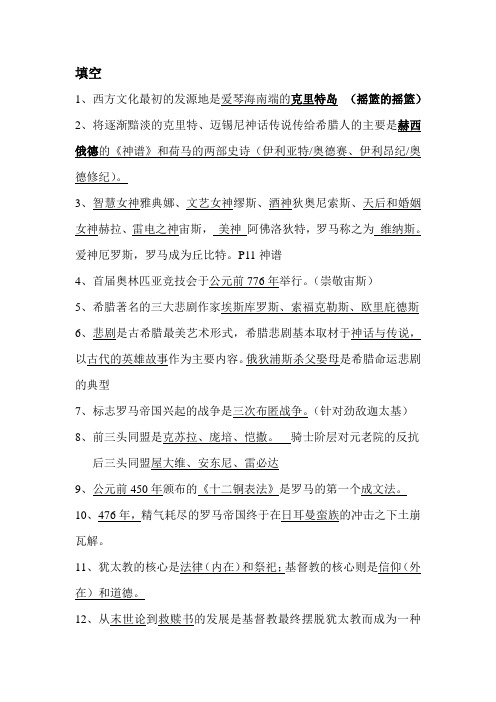
填空1、西方文化最初的发源地是爱琴海南端的克里特岛(摇篮的摇篮)2、将逐渐黯淡的克里特、迈锡尼神话传说传给希腊人的主要是赫西俄德的《神谱》和荷马的两部史诗(伊利亚特/奥德赛、伊利昂纪/奥德修纪)。
3、智慧女神雅典娜、文艺女神缪斯、酒神狄奥尼索斯、天后和婚姻女神赫拉、雷电之神宙斯,美神阿佛洛狄特,罗马称之为维纳斯。
爱神厄罗斯,罗马成为丘比特。
P11神谱4、首届奥林匹亚竞技会于公元前776年举行。
(崇敬宙斯)5、希腊著名的三大悲剧作家埃斯库罗斯、索福克勒斯、欧里庇德斯6、悲剧是古希腊最美艺术形式,希腊悲剧基本取材于神话与传说,以古代的英雄故事作为主要内容。
俄狄浦斯杀父娶母是希腊命运悲剧的典型7、标志罗马帝国兴起的战争是三次布匿战争。
(针对劲敌迦太基)8、前三头同盟是克苏拉、庞培、恺撒。
骑士阶层对元老院的反抗后三头同盟屋大维、安东尼、雷必达9、公元前450年颁布的《十二铜表法》是罗马的第一个成文法。
10、476年,精气耗尽的罗马帝国终于在日耳曼蛮族的冲击之下土崩瓦解。
11、犹太教的核心是法律(内在)和祭祀;基督教的核心则是信仰(外在)和道德。
12、从末世论到救赎书的发展是基督教最终摆脱犹太教而成为一种独立的世界性宗教的重大标志。
13、如果说犹太教为基督教提供了圣教历史的肉身,那么希腊唯心主义哲学为基督教提供了唯灵主义的精神。
14、313年,君士坦丁在米兰与东罗马帝国的皇帝利西尼乌斯共同颁布了就一个敕令,即著名的《米兰敕令》又称《宽容敕令》。
米兰敕令标志着基督教在经受了250年迫害后终于在罗马帝国获得了合法地位。
15、西欧封建社会经济生活的基本单元是“小而全”的庄园16、中世纪西欧的封建制是一种名副其实的封建制,它由“宗主”或“领主”或“封臣”之间的层层分封的金字塔形结构所组成。
17、到了10世纪,修道院已经发展成西欧的最大庄园主,修道院经济基本上控制了整个西欧的经济命脉。
18、1305年腓力推选出法国波尔多大主教继任教皇,即克雷芒五世,随后把教廷从罗马迁至法国飞的阿维农,置于法王的控制之下,自此开始了长达70年之久的“阿维农之囚”。
(完整word版)西方文化概论

西方文化概论克里特文明1【单选题】克里特文明开始突然衰落是从公元前(C)以后。
A、14世纪B、16世纪C、15世纪D、13世纪2【单选题】根据考古发掘,西方文明是起始于(A)左右以前。
A、4500年B、3000年C、4000年D、5000年3【单选题】以下哪一项是西方文明最早的源头?(A)A、克里特岛B、埃及C、罗马D、以上都对4【判断题】爱琴文明不是最早的希腊文明.(×)5【判断题】西方文明的摇篮是希腊文明.(√)迈锡尼文明1【单选题】被称为“英雄时代”,是希腊文明中的(D)。
A、克里特文明时代B、希腊文明时代C、迈锡尼文明时代D、黑暗时代2【单选题】以下关于迈锡尼文明时期,北方入侵的三支浪潮的说法正确的是哪一项?(B)A、第一、二支是暴力入侵B、第一支浪潮是和平渗透C、第一、二支是和平渗透D、第一、三支是暴力入侵3【单选题】按照早到晚顺序将几个希腊文明的阶段进行排序,正确的是(A).A、克里特文明、迈锡尼文明、黑暗时代、希腊文明B、克里特文明、迈锡尼文明、希腊文明、黑暗时代C、迈锡尼文明、克里特文明、希腊文明、黑暗时代D、克里特文明、黑暗时代、迈锡尼文明、希腊文明4【判断题】迈锡尼文明有对克里特文明的借鉴,也有北方粗狂的特点。
(√)5【判断题】希腊土居最早建立了迈锡尼文明。
(×)爱琴神话1【单选题】以下哪一位是最早编撰古希腊神话的神谱的游吟诗人?(D)A、亚里士多德B、荷马C、柏拉图D、赫西俄德2【单选题】集中在(A)的两个半岛的是希腊最主要的文明。
A、南方B、北方C、东方D、西方3【单选题】最早时期,奥运会是一种(A)。
A、祭祀活动B、体育比赛C、筛选官兵的方式D、娱乐活动4【判断题】神兽同形同性是希腊神话中一个显著的特点。
(×)5【判断题】克里特神话包括“阿德涅之线”和“代达罗斯的故事”.(√)赫西俄德与荷马1【单选题】古希腊神话中,大地之神该亚在未经交配的情况下就生下了(D).A、大海之神和动物之神B、天宇之神和星月之神C、动物之神和山河之神D、大海之神和天宇之神2【单选题】荷马和赫西俄德生活在下面哪一时期?(C)A、城邦文明时期B、克里特文明时期C、黑暗时代将尽D、以上都不对3【单选题】认为(A)有血缘关系是希腊神话的特点之一.A、英雄和神B、老百姓和神C、统治者和神D、士兵和神4【判断题】让人关注故事和英雄背后的命运是希腊悲剧的深刻性所在。
西方文化概论考试题
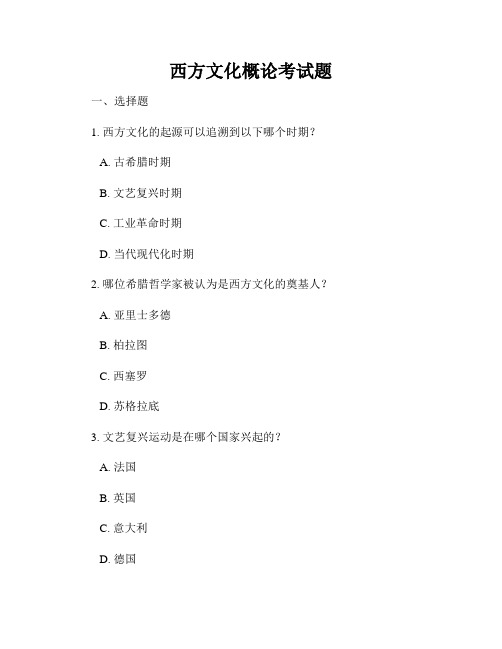
西方文化概论考试题一、选择题1. 西方文化的起源可以追溯到以下哪个时期?A. 古希腊时期B. 文艺复兴时期C. 工业革命时期D. 当代现代化时期2. 哪位希腊哲学家被认为是西方文化的奠基人?A. 亚里士多德B. 柏拉图C. 西塞罗D. 苏格拉底3. 文艺复兴运动是在哪个国家兴起的?A. 法国B. 英国C. 意大利D. 德国4. 哪本书是英国文艺复兴时期最重要的著作之一?A. 《圣经》B. 《简·爱》C. 《哈姆雷特》D. 《唐吉诃德》5. 哪位科学家被称为现代物理学之父?A. 牛顿B. 达尔文C. 哥白尼D. 欧几里德二、判断题判断下列说法是否正确,正确的在括号内写“√”,错误的写“×”。
1. (√)《罗密欧与朱丽叶》是莎士比亚的作品,属于英国文艺复兴时期的戏剧。
2. (×)文艺复兴运动对欧洲其他国家的文化影响不大,主要局限于意大利地区。
3. (√)工业革命对西方社会产生了巨大的影响,使之从传统农业社会转变为现代工业社会。
4. (×)西方文化的核心是个人主义和自由,与集体主义和权威主义完全不同。
5. (√)西方文化中的人文主义强调人的尊严和价值,提倡人类的自由发展和个体意识的觉醒。
三、问答题1. 请简要介绍西方文化的主要特点和价值观。
西方文化的主要特点包括个人主义、理性主义、人权和科学精神等。
个人主义强调个体的独立性和个人权利,在人际关系和社会交往中强调个体的意愿和选择。
理性主义崇尚理性思维和科学方法,在知识的获取和问题解决中强调逻辑和分析。
人权是西方文化的核心价值观之一,认为每个人都享有平等的尊重和权利。
科学精神是对客观世界的追求和理解,注重实证和证据的支持。
2. 西方文化中的哪些艺术形式对世界产生了深远的影响?西方文化中的艺术形式包括文学、音乐、绘画、雕塑、戏剧和电影等。
其中,莎士比亚的戏剧作品被认为是世界戏剧史上的巅峰之作,对后世的文学和戏剧创作产生了深远的影响。
西方文化概论填空

填空1、西方文化最初的发源地是爱琴海南端的克里特岛(摇篮的摇篮)2、将逐渐黯淡的克里特、迈锡尼神话传说传给希腊人的主要是赫西俄德的《神谱》和荷马的两部史诗(伊利亚特/奥德赛、伊利昂纪/奥德修纪)。
3、智慧女神雅典娜、文艺女神缪斯、酒神狄奥尼索斯、天后和婚姻女神赫拉、雷电之神宙斯,美神阿佛洛狄特,罗马称之为维纳斯。
爱神厄罗斯,罗马成为丘比特。
P11神谱4、首届奥林匹亚竞技会于公元前776年举行。
(崇敬宙斯)5、希腊著名的三大悲剧作家埃斯库罗斯、索福克勒斯、欧里庇德斯6、悲剧是古希腊最美艺术形式,希腊悲剧基本取材于神话与传说,以古代的英雄故事作为主要内容。
俄狄浦斯杀父娶母是希腊命运悲剧的典型7、标志罗马帝国兴起的战争是三次布匿战争。
(针对劲敌迦太基)8、前三头同盟是克苏拉、庞培、恺撒。
骑士阶层对元老院的反抗后三头同盟屋大维、安东尼、雷必达9、公元前450年颁布的《十二铜表法》是罗马的第一个成文法。
10、476年,精气耗尽的罗马帝国终于在日耳曼蛮族的冲击之下土崩瓦解。
11、犹太教的核心是法律(内在)和祭祀;基督教的核心则是信仰(外在)和道德。
12、从末世论到救赎书的发展是基督教最终摆脱犹太教而成为一种独立的世界性宗教的重大标志。
13、如果说犹太教为基督教提供了圣教历史的肉身,那么希腊唯心主义哲学为基督教提供了唯灵主义的精神。
14、313年,君士坦丁在米兰与东罗马帝国的皇帝利西尼乌斯共同颁布了就一个敕令,即著名的《米兰敕令》又称《宽容敕令》。
米兰敕令标志着基督教在经受了250年迫害后终于在罗马帝国获得了合法地位。
15、西欧封建社会经济生活的基本单元是“小而全”的庄园16、中世纪西欧的封建制是一种名副其实的封建制,它由“宗主”或“领主”或“封臣”之间的层层分封的金字塔形结构所组成。
17、到了10世纪,修道院已经发展成西欧的最大庄园主,修道院经济基本上控制了整个西欧的经济命脉。
18、1305年腓力推选出法国波尔多大主教继任教皇,即克雷芒五世,随后把教廷从罗马迁至法国飞的阿维农,置于法王的控制之下,自此开始了长达70年之久的“阿维农之囚”。
西方文化概论考试试题参考
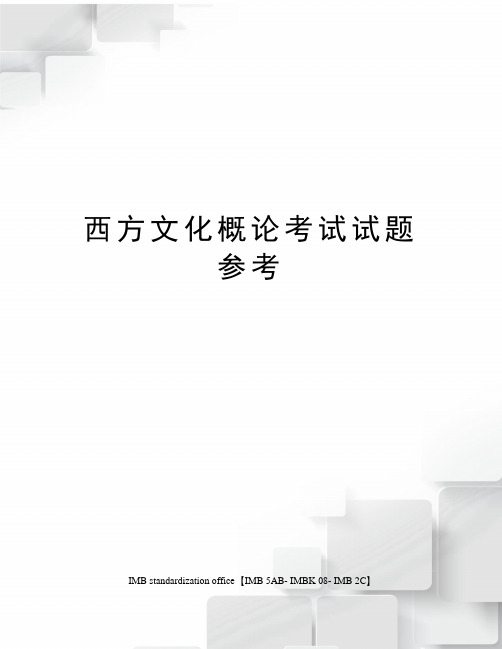
西方文化概论考试试题参考IMB standardization office【IMB 5AB- IMBK 08- IMB 2C】西方文化概论试题参考一、名词解释:1、命运:A、命运是希腊悲剧的基本主题,它是潜藏在悲剧主人公的自由行动背后的一种决定论力量,最典型的命运悲剧如《俄底浦斯王》等;B、希腊悲剧中的命运在稍后的希腊哲学中发展为决定现象的本质,其实质即不依人的意志为转移的自然规律或社会规律。
2、布匿战争:A、布匿战争是罗马人对外扩张的第一场战争,其对手是地中海南岸的迦太基,该战争共打了三次,以罗马的最终胜利和迦太基的灭亡而告终;B、布匿战争加速了罗马对外扩张的步伐,成为罗马称霸地中海世界的序幕。
3、修道运动:随着基督教的国教化,到了4世纪末,基督徒已经在罗马人口中占有多数。
主教们开始为它的纯洁而忧虑。
修道运动的最初是真诚的基督徒面对罗马世界中普遍的堕落现象而采取的一种洁身自好的应战状态,它的本义是为了维护基督教道德的严谨性和纯洁性。
基督教的圣徒们为了上帝的缘故而折磨自己的肉体,以独身、清贫、禁欲和脱离尘世的沉思冥想来与骄奢淫逸的罗马生活方式抗衡。
4、因信称义A、马丁·路德宗教改革的主要神学思想,它的基本内容是:只有信仰才是得救(称义)的唯一根据;B、“因信称义”思想的意义在于,与中世纪罗马天主教会所宣扬的各种善功称义思想针锋相对,反对通过买卖赎罪券等活动来达到称义目的的虚伪主张。
5、前三头同盟A、前三头同盟是指罗马共和国晚期克拉苏、庞培、恺撒三人缔结的政治同盟;B、前三头同盟的出现标志着罗马共和国已经走向没落,骑士阶层开始公开地与元老院相抗衡,并且逐渐控制了罗马共和国的命运。
6、弥赛亚运动:“弥赛亚”一词源自希伯来文,希腊文译作基督,本意为受膏者或受上帝祝福的人。
在犹太人中弥赛亚与君主、救世主同义,每当犹太人受到本族或异族的统治者的压迫和欺凌,生活痛苦无法忍受时,就会有一位犹太人宣布自己就是众所期待的弥赛亚,领导犹太人进行反抗运动。
西方文化概论1-4章复习题
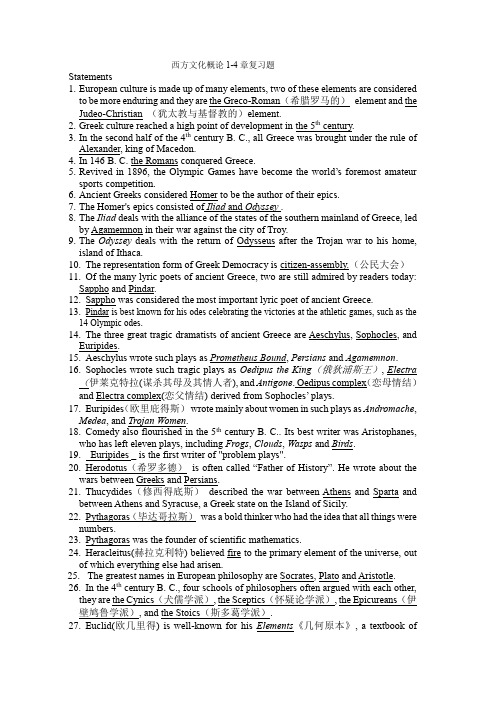
西方文化概论1-4章复习题Statements1.European culture is made up of many elements, two of these elements are consideredto be more enduring and they are the Greco-Roman(希腊罗马的)element and the Judeo-Christian (犹太教与基督教的)element.2.Greek culture reached a high point of development in the 5th century.3.In the second half of the 4th century B. C., all Greece was brought under the rule ofAlexander, king of Macedon.4.In 146 B. C. the Romans conquered Greece.5.Revived in 1896, the Olympic Games have become the world’s foremost amateursports competition.6.Ancient Greeks considered Homer to be the author of their epics.7.The Homer's epics consisted of Iliad and Odyssey .8.The Iliad deals with the alliance of the states of the southern mainland of Greece, ledby Agamemnon in their war against the city of Troy.9.The Odyssey deals with the return of Odysseus after the Trojan war to his home,island of Ithaca.10.The representation form of Greek Democracy is citizen-assembly.(公民大会)11.Of the many lyric poets of ancient Greece, two are still admired by readers today:Sappho and Pindar.12.Sappho was considered the most important lyric poet of ancient Greece.13.Pindar is best known for his odes celebrating the victories at the athletic games, such as the14 Olympic odes.14.The three great tragic dramatists of ancient Greece are Aeschylus, Sophocles, andEuripides.15.Aeschylus wrote such plays as Prometheus Bound, Persians and Agamemnon.16.Sophocles wrote such tragic plays as Oedipus the King(俄狄浦斯王), Electra(伊莱克特拉(谋杀其母及其情人者), and Antigone. Oedipus complex(恋母情结)and Electra complex(恋父情结) derived from Sophocles’ plays.17.Euripides(欧里庇得斯)wrote mainly about women in such plays as Andromache,Medea, and Trojan Women.edy also flourished in the 5th century B. C.. Its best writer was Aristophanes,who has left eleven plays, including Frogs, Clouds, Wasps and Birds.19.Euripides _ is the first writer of "problem plays".20.Herodotus(希罗多德)is often called “Father of History”. He wrote about thewars between Greeks and Persians.21.Thucydides(修西得底斯)described the war between Athens and Sparta andbetween Athens and Syracuse, a Greek state on the Island of Sicily.22.Pythagoras(毕达哥拉斯)was a bold thinker who had the idea that all things werenumbers.23.Pythagoras was the founder of scientific mathematics.24.Heracleitus(赫拉克利特) believed fire to the primary element of the universe, outof which everything else had arisen.25.The greatest names in European philosophy are Socrates, Plato and Aristotle.26.In the 4th century B. C., four schools of philosophers often argued with each other,they are the Cynics(犬儒学派), the Sceptics(怀疑论学派), the Epicureans(伊壁鸠鲁学派), and the Stoics(斯多葛学派).27.Euclid(欧几里得) is well-known for his Elements《几何原本》, a textbook ofgeometry.28.To illustrate the principle of the level, Archimedes is said to have told the king: “Give me a place to stand, and I will move the world.”29.Greek architecture can be grouped into three styles: the Doric (多利安式)style which is also called the masculine style; the Ionic(爱奥尼亚式)style which is also called the feminine style; and a later style that is called the Corinthian(科林斯式)style.30.The Acropolis at Athens(雅典卫城)and the Parthenon(万神殿) are the finest monument of Greek architecture and sculpture in more than 2000 years.31.The burning of Corinth in 146 B. C. marked Roman conquest of Greece, which was then reduced to a province of the Roman Empire.32.The Roman writer Horace said: “Captive Greece took her rude conqueror captive”.大意:征服者反被被征服者所征服。
西方文化概论(Z01K02)
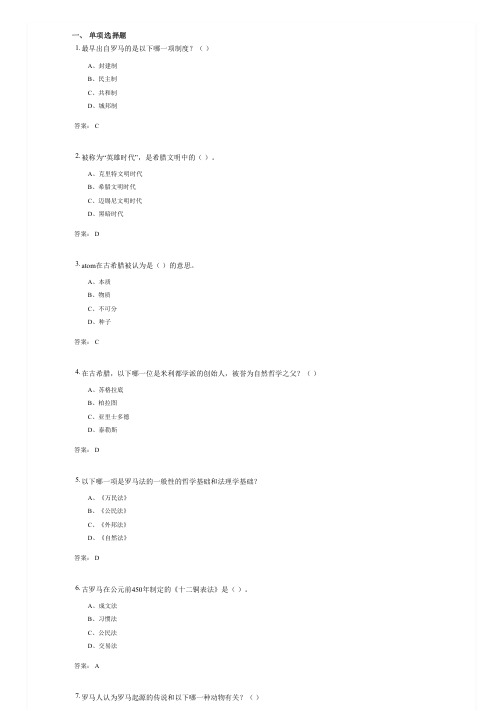
一、单项选择题1.最早出自罗马的是以下哪一项制度?()A、封建制B、民主制C、共和制D、城邦制答案: C2.被称为“英雄时代”,是希腊文明中的()。
A、克里特文明时代B、希腊文明时代C、迈锡尼文明时代D、黑暗时代答案: D3.atom在古希腊被认为是()的意思。
A、本质B、物质C、不可分D、种子答案: C4.在古希腊,以下哪一位是米利都学派的创始人,被誉为自然哲学之父?()A、苏格拉底B、柏拉图C、亚里士多德D、泰勒斯答案: D5.以下哪一项是罗马法的一般性的哲学基础和法理学基础?A、《万民法》B、《公民法》C、《外邦法》D、《自然法》答案: D6.古罗马在公元前450年制定的《十二铜表法》是()。
A、成文法B、习惯法C、公民法D、交易法答案: A7.罗马人认为罗马起源的传说和以下哪一种动物有关?()A、狼B、豹C、狗D、狮子答案: A8.凯撒最终遭到()刺杀而身亡。
A、屋大维B、埃及艳后C、罗马元老D、高卢人答案: C二、判断题1.在罗马历中,将七月献给奥古斯都,将八月献给凯撒。
A、正确B、错误答案:错误2.爱琴文明不是最早的希腊文明。
A、正确B、错误答案:错误3.希腊在希波战争之前,是分离主义,战争之后,开始帝国主义。
A、正确B、错误答案:正确4.古希腊的悲剧往往产生于好人和坏人之间的冲突,体现的是善恶相争的结果。
A、正确B、错误答案:错误5.希腊土居最早建立了迈锡尼文明。
A、正确B、错误答案:错误6.三权分立的最初模型的形成是在伯里克利时期,雅典民主制度完成时。
A、正确B、错误答案:正确7.法国的启蒙运动传入德国后就变成了思想的大革命。
A、正确B、错误答案:正确8.迈锡尼文明有对克里特文明的借鉴,也有北方粗狂的特点。
A、正确B、错误答案:正确9.伊斯坦布尔的由来是土耳其入侵罗马帝国后,将君士坦丁堡改名而来的。
A、正确B、错误答案:正确10.罗马的政治中心是东罗马,官方语言是拉丁语。
A、正确B、错误答案:错误11.古希腊时期,立法者吕库古进行了彻底的政治改革,废除了债务奴隶。
西方文化概论试题汇编
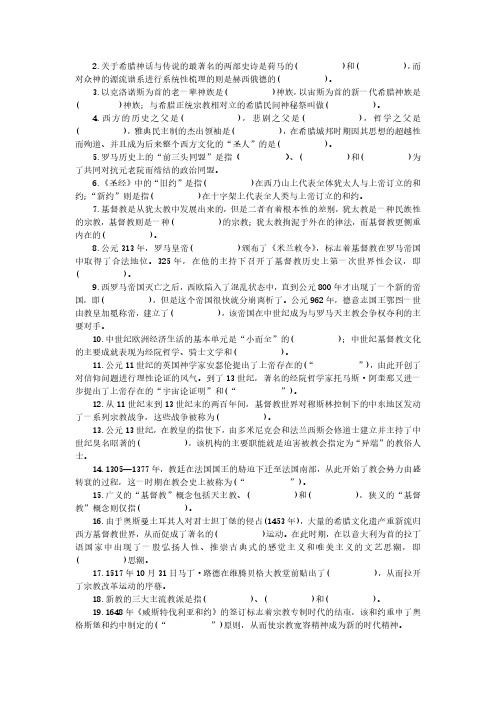
2.关于希腊神话与传说的最著名的两部史诗是荷马的()和(),而对众神的源流谱系进行系统性梳理的则是赫西俄德的()。
3.以克洛诺斯为首的老一辈神族是()神族,以宙斯为首的新一代希腊神族是()神族;与希腊正统宗教相对立的希腊民间神秘祭叫做()。
4.西方的历史之父是(),悲剧之父是(),哲学之父是(),雅典民主制的杰出领袖是(),在希腊城邦时期因其思想的超越性而殉道、并且成为后来整个西方文化的“圣人”的是()。
5.罗马历史上的“前三头同盟”是指()、()和()为了共同对抗元老院而缔结的政治同盟。
6.《圣经》中的“旧约”是指()在西乃山上代表全体犹太人与上帝订立的和约;“新约”则是指()在十字架上代表全人类与上帝订立的和约。
7.基督教是从犹太教中发展出来的,但是二者有着根本性的差别,犹太教是一种民族性的宗教,基督教则是一种()的宗教;犹太教拘泥于外在的律法,而基督教更侧重内在的()。
8.公元313年,罗马皇帝()颁布了《米兰敕令》,标志着基督教在罗马帝国中取得了合法地位。
325年,在他的主持下召开了基督教历史上第一次世界性会议,即()。
9.西罗马帝国灭亡之后,西欧陷入了混乱状态中,直到公元800年才出现了一个新的帝国,即(),但是这个帝国很快就分崩离析了。
公元962年,德意志国王鄂图一世由教皇加冕称帝,建立了(),该帝国在中世纪成为与罗马天主教会争权夺利的主要对手。
10.中世纪欧洲经济生活的基本单元是“小而全”的();中世纪基督教文化的主要成就表现为经院哲学、骑士文学和()。
11.公元11世纪的英国神学家安瑟伦提出了上帝存在的(“”),由此开创了对信仰问题进行理性论证的风气。
到了13世纪,著名的经院哲学家托马斯·阿奎那又进一步提出了上帝存在的“宇宙论证明”和(“”)。
12.从11世纪末到13世纪末的两百年间,基督教世界对穆斯林控制下的中东地区发动了一系列宗教战争,这些战争被称为()。
13.公元13世纪,在教皇的指使下,由多米尼克会和法兰西斯会修道士建立并主持了中世纪臭名昭著的(),该机构的主要职能就是迫害被教会指定为“异端”的教俗人士。
西方文化概论课后答案完整版、填空题、名词解释、论述题

第一章古希腊罗马文化第一节1、如何认识古希腊文明的时间跨度和空间范围?(1)、地域范围:古代希腊的概念是一个大希腊的概念,包括希腊本土、小亚细亚和西亚沿海地区、南意大利地区,甚至伊比利亚半岛和北非。
(2)、时间跨度:古代希腊文化包括三个发展阶段:A、克里特-迈锡尼时代的文化(公元前26-前12世纪)黑暗时代(公元前12-前8世纪)B、希腊城邦时代的文化(公元前8-前4世纪)C、希腊化时代的文化(公元前4-前2世纪)2、赫西俄德的《神谱》具有什么文化学意义?从文化学角度来看,赫西俄德的《神谱》具有两方面的重要意义:第一,它通过神系的生殖原则反映了一种朴素的宇宙起源论和自然演化观;第二,它蕴含着一种自我否定为动力的社会进化思想。
从第一方面来看,希腊神话的神谱不仅仅是神的家族史,同时也反映了希腊人的宇宙生成观,神的衍生和交替也就是自然过程的发生和演进。
这种通过神系的生殖原则来说明宇宙起源和自然演化过程的神话思维图景,构成了哲学和科学产生之前人们唯一的世界观。
从第二方面来看,以内在的自我否定作为神系延续和发展的契机是希腊神话的又一个基本特征。
这种维持神系更新和发展的自我否定机制使希腊神话表现出一种新陈代谢的社会进化思想,而在背后决定着诸神的兴衰泰否的就是那个不出场的“命运”。
这种通过“命运”的“看不见之手”来实现神系更迭和自然进化的思想,构成了希腊神话中最深刻的思想,同时也成为整个西方文化在漫长的历史过程中不断实现自我否定和自我超越的形而上的动力。
第二节1、希腊神话的“神人同形同性”特点反映了什么样的文化精神?第一,反映了对现实生活的珍视,这是希腊宗教和希腊文化的一个显著特点.希腊人的神是人性的神,希腊人的宗教是人性的宗教.使得希腊人带有很强烈的人文主义精神.第二,自然崇拜和感觉主义构成了最基本的特征.自然崇拜主要表现对人的自然形体的崇拜,感觉主义则主要表现对美的事物和现实生活的热爱.第三,”神人同形同性”特点反映了希腊和谐之美的文化精神,这一精神成为西方人心中失落而难以复返的精神家园,滋润着被种种功利要求、上帝呼唤和道德命令折磨得疲惫不堪的灵魂的清纯之泉。
《西方文化概论》自考

《西方文化概论》复习题(本部)练习题1、四年一届的(奥林匹亚竞技会)是全希腊最隆重的盛会。
2、(浪漫主义)主义的基本特点就是,用自由和美感来代替义务和功利,用情感的权威来代替理性的权威,用个人的立场来代替国家的立场。
3、卢梭的小说(新爱洛伊丝)是浪漫主义的典范,在这本书中,卢梭第一次把真挚炽热的情感凌驾于崇高典雅的荣誉和义务之上。
4、当“哲学之父”(泰勒斯)宣称万物是从水中产生时,他第一次以哲学的方式表达了本原的思想。
5、真正的爱琴文明主要是指(米诺斯文明),它在公元前17—前15世纪达到了鼎盛时期。
6、20世纪初期普朗克的量子论和爱因斯坦的(相对论)揭开了现代物理学革命的序幕。
7、分离主义的政治态度和自由主义的生活信念构成了希腊(城邦)社会的重要特征。
8、莫尔和闵采尔的乌托邦理想成为近代西方(共产主义)理论的思想根源。
9、公元前5世纪,(雅典)成为全希腊的政治、经济和文化的中心,成为希腊各个城邦人们敬仰和向往的圣地。
10、人文主义的精神实质就是(人性的解放),它的目的是把人们从自然欲望的满足和感性享乐由教士阶层的偷偷摸摸的勾当转变为所有人理直气壮的行为。
11、“基督教的真正父亲”(保罗)构建了基督教的基本教义—“道成肉身”—理论的雏形。
12、基督教在哲学上对应一种(唯心主义)观点,即把精神看得比物质更加具有根本性。
13、从迈锡尼文明灭亡到希腊城邦文明诞生,中间经历了长达三个世纪的、所谓的(黑暗时代)或者“英雄时代”。
14、(哥特式)建筑以纤巧华丽的艺术风格和怪诞夸张的浪漫气质而著称于世,它构成了中世纪基督教文化的标志性成就。
15、(《尼西亚信经》)确立了“三位一体”和“基督神人二性联合而互不混淆”的正统教义,并且树立起教会在人间的绝对权威,成为后世基督教世界一致同意的普世宣言。
16、公元前8世纪,当新兴的希腊城邦文化逐渐从“黑暗时代”的文化废墟中生长出来时,与城邦的殖民化过程相互伴随的文化形式是(系统叙事诗)。
西方文化概论复习题

一.名词解释1.轴心时代:公元前800至前200年之间,是人类文明精神的重大突破时期,具有同步性,普遍性,历时性特点。
各文明出现伟大精神导师——苏格拉底,柏拉图,亚里士多德,以色列犹太教先知;古印度释迦牟尼,中国孔子,老子,其原则奠定各自文化传统并一直延续到今天。
2.双希文明:希腊文明代表理性精神,表现在以奥林匹斯山众神为首的神学和以苏格拉底,柏拉图为首的哲学(包括立法管理,国家建设)。
希伯来文明代表信仰精神,表现在基督教文化,宗教伦理,强调献身性。
它们是西方文明的两大源头。
3.西方中心论:是一种文化自我中心态度,认为西方文化优于,高于非西方文明,或认为人类文化围绕西方文化展开,或认为西方文化形态,理想与价值方式具有普遍性意义从而代表非西方文化未来发展方向,黑格尔是典型代表。
4.爱琴文明:包括基克拉迪文明,最高艺术成就——大理石雕塑;克里特文明——宫廷建筑与绘画,公元前1450年走向衰落;迈锡尼文明——金工,是北方游牧文化与克里特文明相融合的结果。
5.柏拉图:古希腊哲学家和教育家,西方客观唯心主义奠基人,出身雅典贵族。
认为理论,现实,艺术三个世界等而下之,理念世界脱离现实世界而独立存在,现实世界是理念世界的幻象,艺术世界时“摹本的摹本”。
其理论综合了本原论、认识论、灵魂论,伦理观以及社会政治学说,是希腊哲学中第一个完整成熟的理论体系,著有《理想国》。
6.哲学家王:柏拉图提出的天才治国说,认为法律和道德在堕落,要公正地治理国家和重建一种新的道德是极其困难的,而哲学家的统治就是知识或智慧的统治,是理想的治国方式。
7.古典主义:西欧文学(特别是法国)艺术上的一个流派,盛行于17世纪,主要特点是模仿古希腊罗马的艺术形式,尊重传统崇尚理性,表现反宗教权威的精神,但模仿多创造少,不能反映现实。
(政治基础是中央集权君主专制,哲学基础是笛卡尔的唯理主义理论)8.哥特式建筑:是当时繁琐的经院哲学的物质的形象的表征,以整体的宏大与细节的繁复来撼动人心。
自学考试《外国文化导论》填空题专项练习
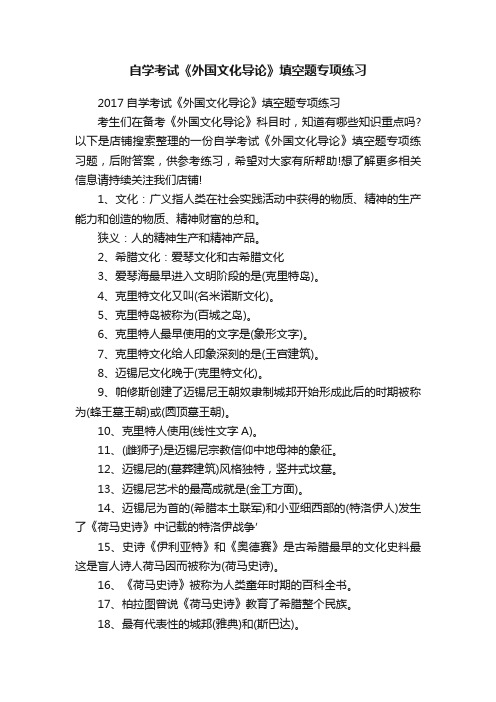
自学考试《外国文化导论》填空题专项练习2017自学考试《外国文化导论》填空题专项练习考生们在备考《外国文化导论》科目时,知道有哪些知识重点吗?以下是店铺搜索整理的一份自学考试《外国文化导论》填空题专项练习题,后附答案,供参考练习,希望对大家有所帮助!想了解更多相关信息请持续关注我们店铺!1、文化:广义指人类在社会实践活动中获得的物质、精神的生产能力和创造的物质、精神财富的总和。
狭义:人的精神生产和精神产品。
2、希腊文化:爱琴文化和古希腊文化3、爱琴海最早进入文明阶段的是(克里特岛)。
4、克里特文化又叫(名米诺斯文化)。
5、克里特岛被称为(百城之岛)。
6、克里特人最早使用的文字是(象形文字)。
7、克里特文化给人印象深刻的是(王宫建筑)。
8、迈锡尼文化晚于(克里特文化)。
9、帕修斯创建了迈锡尼王朝奴隶制城邦开始形成此后的时期被称为(蜂王墓王朝)或(圆顶墓王朝)。
10、克里特人使用(线性文字A)。
11、(雌狮子)是迈锡尼宗教信仰中地母神的象征。
12、迈锡尼的(墓葬建筑)风格独特,竖井式坟墓。
13、迈锡尼艺术的最高成就是(金工方面)。
14、迈锡尼为首的(希腊本土联军)和小亚细西部的(特洛伊人)发生了《荷马史诗》中记载的特洛伊战争’15、史诗《伊利亚特》和《奥德赛》是古希腊最早的文化史料最这是盲人诗人荷马因而被称为(荷马史诗)。
16、《荷马史诗》被称为人类童年时期的百科全书。
17、柏拉图曾说《荷马史诗》教育了希腊整个民族。
18、最有代表性的城邦(雅典)和(斯巴达)。
19、斯巴达城邦称雄于(伯罗奔尼撒半岛)。
20、斯巴达宪法下的最高权力被赋予一个名为“检察院”。
21、希腊人的宗教主要是对(奥林匹斯山)诸神的崇拜。
22、全希腊性质的竞技活动被称为(泛希腊运动会)最著名的是(奥林匹克运动会)。
23、(泛雅典娜节)是全希腊性宗教庆典。
24、米利都学派的(泰勒斯)被认为是西方历史上的第一位哲学家。
25、米利都三杰:阿克那西曼德、克那西美尼、泰勒斯。
西方文化概论填空题(必考知识点)
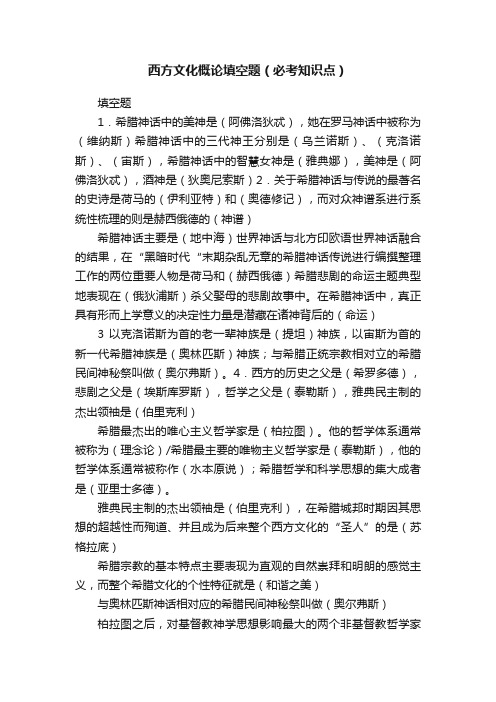
西方文化概论填空题(必考知识点)填空题1.希腊神话中的美神是(阿佛洛狄忒),她在罗马神话中被称为(维纳斯)希腊神话中的三代神王分别是(乌兰诺斯)、(克洛诺斯)、(宙斯),希腊神话中的智慧女神是(雅典娜),美神是(阿佛洛狄忒),酒神是(狄奥尼索斯)2.关于希腊神话与传说的最著名的史诗是荷马的(伊利亚特)和(奥德修记),而对众神谱系进行系统性梳理的则是赫西俄德的(神谱)希腊神话主要是(地中海)世界神话与北方印欧语世界神话融合的结果,在“黑暗时代“末期杂乱无章的希腊神话传说进行编撰整理工作的两位重要人物是荷马和(赫西俄德)希腊悲剧的命运主题典型地表现在(俄狄浦斯)杀父娶母的悲剧故事中。
在希腊神话中,真正具有形而上学意义的决定性力量是潜藏在诸神背后的(命运)3 以克洛诺斯为首的老一辈神族是(提坦)神族,以宙斯为首的新一代希腊神族是(奥林匹斯)神族;与希腊正统宗教相对立的希腊民间神秘祭叫做(奥尔弗斯)。
4.西方的历史之父是(希罗多德),悲剧之父是(埃斯库罗斯),哲学之父是(泰勒斯),雅典民主制的杰出领袖是(伯里克利)希腊最杰出的唯心主义哲学家是(柏拉图)。
他的哲学体系通常被称为(理念论)/希腊最主要的唯物主义哲学家是(泰勒斯),他的哲学体系通常被称作(水本原说);希腊哲学和科学思想的集大成者是(亚里士多德)。
雅典民主制的杰出领袖是(伯里克利),在希腊城邦时期因其思想的超越性而殉道、并且成为后来整个西方文化的“圣人”的是(苏格拉底)希腊宗教的基本特点主要表现为直观的自然崇拜和明朗的感觉主义,而整个希腊文化的个性特征就是(和谐之美)与奥林匹斯神话相对应的希腊民间神秘祭叫做(奥尔弗斯)柏拉图之后,对基督教神学思想影响最大的两个非基督教哲学家是(普罗提诺)和(斯多葛)柏拉图关于(理念世界)与感觉世界二远对立的思想成为基督教神学的重要理论来源。
西方教会的著名教父(奥古斯丁)在《上帝之城》一书中为基督教的灵肉对立思想和修道运动奠定了理论基础。
西方文化入门复习题

西方文化入门复习题填空题1. The earliest civilization in Greece was the Cretan Civilization, also known as the Minoan Civilization.2. At the end of Mycenaean civilization, the Trojan War broke out.3. In the 6th Century B.C. the city of Sparta gained greater control of Peloponnesus by organizing an alliance of almost all the Peloponnesian states.4. The Persian wars, which were between Greek states and Persia, ended with The Battle of Marathon.5. In Greek mythology, the Olympian gods include Zeus, Hestia, Poseidon, Hades, Demeter, Hera, and other six gods.6. One of the features of Greek mythology is that gods resembled humans.7. Plato was Socrates’ student and the author of The Republic.8. The Senate was a political institution started from ancient Rome and still part of the parliaments in some western countries.9. The first Triumvirate of Rome included Caesar, Pompey, and Crassus.10. The capital city of Byzantine Empire was Constantinople.11. The exiled Jews systematically recomposed their legends and manuscripts into the book Talmud.12. The Bible of Judaism is the same as the New Testament of Christianity.13. Christianity became the sole official religion of the Roman Empire in 392 AD under the emperor Theodosius.14. Christianity has broken up into several factions, principally the Roman Catholicism, the Eastern Orthodoxy, and the Protestantism.15. After the destruction of Roman Empire in 476, Europe entered the Middle Ages, which lasted about a thousand years or so and was dominated by Germanic people whom the Romans had called savage.16. In the 7th Century, Muhammad, an Arabian merchant, founded the religion of Islam.17. The most striking feature of Renaissance was doubtless the flourishing of humanism, which was exemplified by the developments in science, religion,philosophy, literature, art, and education.18. The two leaders of religious reformation in 16th century were Martin Luther in Germany and John Calvin in France.19. Renaissance art was represented by three towering figures: da Vinci, Michelangelo, and Raphael.20. The Enlightenment, which is generally agreed to have originated in France, marked the beginning of the modern era and laid a solid foundation for the later process of the Western modernization.21. The most important book of the French philosopher Rousseau was The Social Contract which argued against the idea that monarchs were divinely empowered to legislate and theorized about the best way to establish a political community in the face of the problems of commercial society.简答题1. In what sense do you think Roman culture owed its accomplishments to the benefits obtained from Greek culture?2. How was the Jewish civilization developed after a tortuous history of split and unification?3. What are the main components of Christianity?4. Why the Byzantine Empire could stay much longer than the Western Roman Empire?5. What are the major achievements of the Renaissance?6. Briefly introduce two representative figures of the Enlightenment and their central ideas.。
西方文化试题及答案
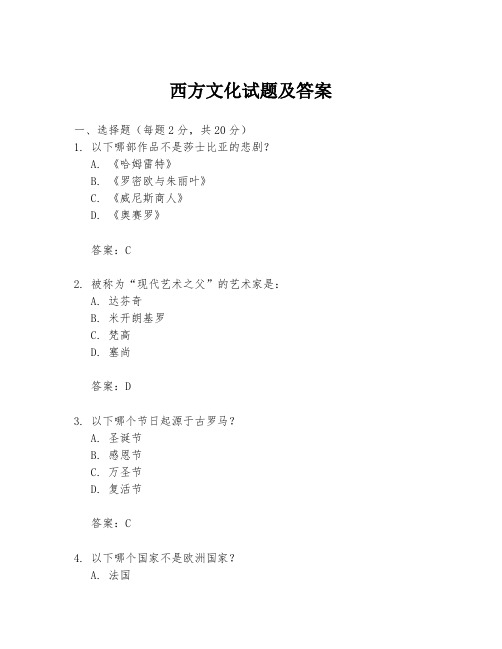
西方文化试题及答案一、选择题(每题2分,共20分)1. 以下哪部作品不是莎士比亚的悲剧?A. 《哈姆雷特》B. 《罗密欧与朱丽叶》C. 《威尼斯商人》D. 《奥赛罗》答案:C2. 被称为“现代艺术之父”的艺术家是:A. 达芬奇B. 米开朗基罗C. 梵高D. 塞尚答案:D3. 以下哪个节日起源于古罗马?A. 圣诞节B. 感恩节C. 万圣节D. 复活节答案:C4. 以下哪个国家不是欧洲国家?A. 法国B. 德国C. 澳大利亚D. 意大利答案:C5. 以下哪个不是西方文化中的四大发明?A. 造纸术B. 印刷术C. 指南针D. 火药答案:A(注:西方文化中的四大发明通常指的是:蒸汽机、电力、内燃机和计算机)二、填空题(每空1分,共10分)1. 被誉为西方哲学之父的是________。
答案:苏格拉底2. 《神曲》是意大利诗人________的代表作。
答案:但丁3. 欧洲文艺复兴运动起源于________世纪的意大利。
答案:144. 现代奥运会的发源地是________。
答案:希腊5. 法国大革命发生在________年。
答案:1789三、简答题(每题10分,共30分)1. 简述文艺复兴时期的主要特点。
答案:文艺复兴时期是欧洲历史上的一个重要时期,主要特点包括对古典文化的复兴,人文主义思想的兴起,科学和艺术的繁荣,以及对个人价值和理性的重视。
2. 描述一下启蒙运动对西方社会的影响。
答案:启蒙运动是18世纪欧洲的一场思想运动,它强调理性、批判传统权威,推动了科学、哲学和政治的发展。
启蒙运动对西方社会产生了深远的影响,包括促进了民主和法治的发展,为现代国家的形成奠定了思想基础。
3. 阐述一下工业革命对西方社会经济和文化的影响。
答案:工业革命是18世纪末到19世纪初的一场技术和社会变革,它极大地提高了生产效率,促进了城市化和资本主义经济的发展。
同时,工业革命也带来了社会结构的变化,促进了教育和文化的普及,对西方社会的经济和文化产生了深远的影响。
西方文化概论习题
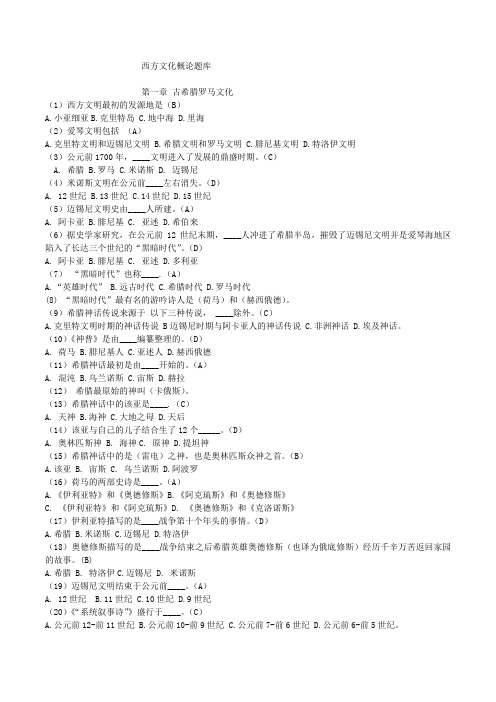
西方文化概论题库第一章古希腊罗马文化(1)西方文明最初的发源地是(B)A.小亚细亚B.克里特岛C.地中海D.里海(2)爱琴文明包括(A)A.克里特文明和迈锡尼文明B.希腊文明和罗马文明C.腓尼基文明D.特洛伊文明(3)公元前1700年,____文明进入了发展的鼎盛时期。
(C)A. 希腊B.罗马C.米诺斯D. 迈锡尼(4)米诺斯文明在公元前____左右消失。
(D)A. 12世纪B.13世纪C.14世纪D.15世纪(5)迈锡尼文明史由____人所建。
(A)A. 阿卡亚B.腓尼基C. 亚述D.希伯来(6)据史学家研究,在公元前12世纪末期,____人冲进了希腊半岛,摧毁了迈锡尼文明并是爱琴海地区陷入了长达三个世纪的“黑暗时代”。
(D)A. 阿卡亚B.腓尼基C. 亚述D.多利亚(7)“黑暗时代”也称____.(A)A.“英雄时代”B.远古时代C.希腊时代D.罗马时代(8) “黑暗时代”最有名的游吟诗人是(荷马)和(赫西俄德)。
(9)希腊神话传说来源于以下三种传说, ____除外。
(C)A.克里特文明时期的神话传说 B迈锡尼时期与阿卡亚人的神话传说 C.非洲神话 D.埃及神话。
(10)《神普》是由____编纂整理的。
(D)A. 荷马B.腓尼基人C.亚述人D.赫西俄德(11)希腊神话最初是由____开始的。
(A)A. 混沌B.乌兰诺斯C.宙斯D.赫拉(12)希腊最原始的神叫(卡俄斯)。
(13)希腊神话中的该亚是____.(C)A. 天神B.海神C.大地之母D.天后(14)该亚与自己的儿子结合生了12个_____。
(D)A. 奥林匹斯神B. 海神C. 原神D.提坦神(15)希腊神话中的是(雷电)之神,也是奥林匹斯众神之首。
(B)A.该亚B. 宙斯C. 乌兰诺斯D.阿波罗(16)荷马的两部史诗是____。
(A)A.《伊利亚特》和《奥德修斯》B.《阿克琉斯》和《奥德修斯》C. 《伊利亚特》和《阿克琉斯》D. 《奥德修斯》和《克洛诺斯》(17)伊利亚特描写的是____战争第十个年头的事情。
西方文化概论复习题

《西方文化概论》复习题1、希伯来文明(2C前)的核心部分是“犹太教”,说说“犹太教”及其对希伯来(犹太)民族的意义。
犹太教信仰宇宙独一真神上帝耶和华,他创造并主宰宇宙万物,他存在于所有的历史事件中,并以某种方式发挥作用。
犹太教的基本教义和公理原则强调上帝耶和华是独一的、统一的、永恒的、万能的、无形的、不可比拟的、无所不在的、无所不知的。
宇宙不存在任何其他上帝,也从未有人可以被奉为神圣。
人类要畏惧上帝、热爱上帝。
犹太教是世界上最古老的一神教,也是与犹太人命运相连的民族宗教。
犹太教孕育在希伯来人的原始信仰之中,诞生于摩西时代,乃至“巴比伦之囚”,经历了一个长期、曲折而又反复多变的历史反战过程,逐步确立下来。
犹太教具有三个明显特点:第一、非偶像崇拜的一神论‘二、以选民观为框架的神学体系;三、核心地位的律法思想。
、影响:1、对犹太民族身份的鉴别。
犹太教即是犹太人的宗教信仰,也是犹太人的民族鉴别标准,“割礼”就是犹太人的民族标记。
犹太人认为,从亚伯纳罕时代起,割礼就一直是上臂与其选民以色列人之间缔结契约的标志。
2、对风俗节日的影响。
守安息日和遵守饮食法是犹太人日常生活中最重要和最基本的生活习俗。
3、对教育和艺术的影响。
《旧约》不仅是犹太教的经典,也是犹太民族的历史、文学作品,可以说是犹太教对犹太民族影响的一个缩影。
从中我们可以看出犹太教对于教育的影响。
在造型艺术方面,我们则可以看出《旧约》中犹太教对于民族艺术的影响。
2、说说对古希腊原欲与理性的理解。
古希腊文学是西方文学的一个重要源头。
古希腊文学的主要成就是希腊神话、荷马史诗和悲剧。
古希腊文学呈现出张扬个性、放纵原欲,肯定人的世俗生活和个体生命价值的特征,这种特征具有根深蒂固的世俗人本意识。
这种意识是原欲型的,虽然其中也不乏理性精神,但这种精神主要是对人的肯定而并非是与原欲相对的理性意识和道德规范。
无论是古希腊神话还是荷马史诗,都鲜明地体现出了这点。
这种原欲性特征根植于古希腊文化的重“天人之别”的土壤“,但同时古希腊文学也沐浴在理性的光辉之中:原欲与理性是古希腊文学内核的两个层面,他们之间的关系既对立又互补,蕴含了人性中不同侧面、不同层次的文化内涵。
西方文化填空

Greek Culture1. Two of the elements in European culture are considered to be more enduring and they are the (Greco-Roman) and the (Judeo-Christian) elements.2. In a more remote period of Greek history, probably around (1200 B.C.), a war was fought between Greece and Troy.3. In the second half of the 4th century B.C., all Greece was brought under the rule of (Alexander), King of Macedon.4. Athens was a democracy, where only the adult (male) citizens had the rights.5. The Greeks loved sports. Once every four years, they had a big festival on (Olympus Mount) which included contests of sports.6. Ancient Greeks considered (Homer) to be the author of their epics: the Iliad and the Odyssey.7. In the 20th century, there are Homeric parallels in the Irishman (James Joyce)’s modernist masterpiece Ulysses.8. Sappho was a (woman)poet noted for her love poems of passionate intensity.9. The Austrian psychiatrist Sigmund Freud’s term (“the Oedipus complex”) was derived from Sophocles’ play.10. Euclid is even now well-known for his Elements, a textbook of (geometry), perhaps the most successful textbook ever written, because it was in use in English schools until the early years of the 20th century.11. To illustrate the principle of the (lever), Archimedes is said to have told the King: “Give me a place to stand, and I will move the world.”12. We know Socrates chiefly through what Plato recorded of him in his famous (Dialogues).13. Plato’s philosophy is called Idealism because in his system of philosophy only such (“ideas”) as beauty, truth and goodness are regarded as completely real while the physical world is regarded as only relatively real.14. Aristotle thought that(“form”)and matter together made up concrete individual realities.15. the most important of the temples the ancient Greeks left us is the (Parthenon), which has always been a great tourist attraction for people all over the world.16. Venus de Milo is the most famous of all the sculptures of Venus, discovered in the island of Milo in 1820. Its (broken) arms have long been the focus of discussion in artistic circles.17. Lacoon was a priest of (Troy) who warned the Trojans against Greek attack. He was made to suffer a slow death and killed by the serpents with his sons because of this.18. The Greeks set an example by the bold effort they made to understand the world by the use of (human reason).Roman Culture1. The Romans and the Greeks’( religions ) were alike enough for most of their deities to be readily identified—Greek Zeus with Roman Jupiter, Greek Aphrodite with Roman Venus, and so on—and their myths to be fused.2. The Romans and the Greeks’ languages worked in similar ways, and were ultimately related, both being numbers of the (Indo-European)language family which stretches from Bangladesh to Iceland.3. After (395), the Roman Empire was permanently divided into East (the Byzantine Empire) and the West.4. The Colosseum is an enormous amphitheatre built in the center of (Rome) in imperial times. A masterpiece of engineering, it held more than 5000 spectators.5. She-wolf is a statue which illustrates the legend of the creation of (Rome).Bible and Christianity1. Among all the religions by which people seek to worship, (Christianity) is by far the most influential in the West.2. It was the (Jewish) tradition which gave birth to Christianity.3. The Bible is a collection of religious writings comprising two parts: (the Old Testament) and (the New Testament).4. The Old Testament is about (God and the laws of God).5. The New Testament is (the doctrine of Jesus Christ).6. The oldest and most important of the 39 books of the Old Testament are the first (five) books, called Pentateuch.7. Exodus is a religious (history) of the Hebrews during their flight from Egypt, the period when t hey began to receive God’s Law.8. When the world was formed, says the Bible, God created man and woman—(Adam) and (Eve).9. According to the Bible, Adam and Eve lived in perfect happiness in the Garden of (Eden) but were finally driven from it and went forth into the world.10. Around 1300 B.C. Moses, the famous Hebrew leader, went to see the pharaoh of Egypt, telling him that Yahweh wanted the pharaoh to end Hebrew slavery and let the Hebrews leave Egypt. With this began the (Exodus), which lasted forty years.11. At the age of 30, Jesus received the (baptism) at the hands of John Baptist.12. Jesus was betrayed by (Juda).13. Jesus was (rushed to trial and crucified) as a revolutionary preacher and dangerous reformer.14. (Constantine) issued the Edict of Milan in 313, granting religious freedom to all and making Christianity legal.15. Towards the end of the fourth century, four accounts were accepted as part of the New Testament, which tells the beginning of Christianity. The fouraccounts were believed to have been written by (Matthew), (Mark), (Luke) and (John).16. the most ancient extant (Latin) version of the whole Bible is the Vulgate edition by St. Jerome.17. the most important and influential of English Bible is the “Authorized” or (King Ja mes’) version, first published in 1611.The Middle Ages1. In European history, the thousand-year period following the fall the Western Roman Empire in the fifth century is called (the Middle Ages).2. During the Medieval Times there was no central government to keep order. The only organization that seemed to unite Europe was (the Christian church).3. Feudalism in Europe was mainly a system of (land holding) in exchange for military service.4. As a knight during the Medieval Times, one was pledged to protect the weak, to fight for the church, to be loyal to his lord and to respect women of noble birth. These rules were known as (code of chivalry), from which the Western idea of good manners developed.5. Under Feudalism, people of Western Europe were mainly divided into three classes: (clergy), (lords) and (peasants).6. Although the Crusades did not achieve their goal to regain the Holy land, they brought (the East) into closer contact with (the West).7. Dante Alighieri’s masterpiece, (The Divine Comedy), is one of the landmarks of world literature.Renaissance1. Renaissance as a period in Western civilization refers to the period between the (14th) and mid (17th) century.2. “Renaissance” means revival of interest in ancient (Greek) and (Roman) culture.3. Renaissance started in (Florence) and(Venice)with the flowering of paintings, sculpture and architecture. From Italy the movement went to embrace the rest of Europe.4. Where the impact of Renaissance with Italy was most strongly felt in (fine arts), in France it was (literature) and in England it was (philosophy and drama).5. At the heart of the Renaissance philosophy is the assertion of (the greatness of man).6. Themes of the Renaissance paintings changed from purely celestial realm focusing on the stories of the Bible, of God, Jesus and Mary to an appreciation of all aspects of (nature and man).Reformation1. The Reformation was a 16th century religious movement as well as a (socio-political) movement.2. The Reformation was aimed at opposing the absolute authority of the Roman Catholic Church and replacing it with the absolute authority of the (Bible).3. Martin Luther was the (German) leader of the Protestant Reformation. His doctrine marked the first break in the unity of the Catholic Church.4. With 38 plays, 154 (sonnets) and 2 long poems, William Shakespeare has established his giant position in world literature.5. Christopher Columbus discovered the New World in (1492).The Seventeenth Century1. In the seventeenth century, the new science and philosophy in Europe gave a great push to the political struggle waged by the newly emerged class, the (bourgeoisie), and other classes. The century saw the intense political struggle, shown in revolution in England and absolute monarchy in France.2. Copernicus’s chief work The Revolution of the Heavenly Orbs was published in 1543. In this mathematical description of the heavens, Copernicus put forward his theory that the (sun), not the earth, is the center of the universe.3. Galileo held that every body, if left alone, will continue to move in a straight line with uniform velocity; any change either in the rapidity or the direction of motion, requires to be explained as due to the action of some “force”. This principle is called (the law of inertia).4. Of all the achievements in physics, Newton’s discovery of the law of the (universal gravitation) is the most important, which states that every body attracts every other with a force directly proportional to the product of their masses and inversely proportional to the square of the distance between them.5. Baroque art is characterized by (dramatic intensity)and sentimental appeal with a lot of emphasis on light and color.6. As a sculptor and architect, (Giovanni Lorenzo Bernini) was the prominent figure of Italian Baroque.7. The name of (Rococo) has been interpreted as being made up of two French words, rocaille, meaning rock and coquille, meaning shell.Enlightenment1. The Enlightenment was an intellectual movement originating in (France). It attracted widespread support among the ruling and intellectual classes of Europe and North America in the second half of the 18th century.2. The Enlightenment is sometimes called (“the Age of Reason“) because it characterizes the efforts by certain European writers to use critical reason to free minds from prejudice, unexamined authority and oppression by Church or State.3. The American War of Independence of 1776 ended British colonial rule over the 18th century. The spirit of this revolution is crystallized in a powerful statement written in (The Declaration of Independence).4. The seizure of the Bastille marked the end of the French monarchy, and the first French Republic was born in 1792. Guiding this revolution was a document called (Declaration of the Rights of Man).5. (The Industrial Revolution), beginning with the invention of the steamengine, rapidly changed the face of the world, and ushered in a completely new age.6. In the book “The Spirit of the Laws”, Montesquieu touched on the theory of (the separation of powers) by examining the British form of government. He believed that the legislative, executive and judicial powers must be confided to different individuals or bodies, acting independently.7. Rousseau believed that a (social contract)was established when each individual gave his rights to a general will—as an equal participant in the political life. Then he was as free after his contract as he has been in the state of nature. He sacrificed his natural freedom for a civil freedom.Romanticism1. Romanticism emphasized (individual) values and aspirations above those of society.2. Romantic literature works, diversified in character and daring in spirit, all depicted man’s eager search for individual freedom, pure sentiments, a nd (ideal beauty).3. The French Revolution in the 18th century established bourgeois democracy with its slogans of (liberty), (equality) and (universal brotherhood).4. The ending of P. B. Shelley’s (Ode to the West Wind)“If winter comes, can spring be f ar behind” has given courage to many revolutionaries faced with reverses, even death.5. To readers in general in France and the world over,(Victor Hugo) is important as the author of Notre Dame de Paris and Les Miserables.6. The Opera House in Paris was a typical example of the revival of the (Baroque) style.Realism1. The chief difference between Romanticism and Realism is that the romantics emphasized feeling and imagination while the realists wanted a truthful representation in their works of (contemporary life and manners).2. Balzac has been called (“the French Dickens “) as Dickens has been called “the English Balzac.3. Within one page Dickens can make the reader burst with laughter and soon wet the book with honest tears. But whatever he wrote he has some basis on (his own experience).4. The term “impressionism” first appeared in 1874 in a newspaper review of an exhibition held in the studio by a group of young painters. It was taken directly from the title of Monet’s (Impression: Sunrise).Modernism1. Modernism has been called (“the tradition of the new “). It was characterized by a conscious rejection of established rules, traditions and conventions. It provided fresh ways of looking at man’s position and function in the universe.2. Modernism has become the synonym of revolution in form. The term “modernist” is usually reserved for more (experimental) and (innovative)modern works, those that view experience in new ways and adopt new forms.3. The Fauves expressed their emotional reaction to the subject in the (boldest colour) and strongest patterns of lines.4. Expressionist art is marked by the expression of reality by means of distortion to communicate one’s inner vision. The artists of this school used bright colors to bring out their (pessimistic) views of life.5. (Cubism)is type of abstract painting which aims to penetrate beyond surface appearances and single vision and depict persons and objects from varying angles simultaneously and three dimensionally.6. Dadaists created works that were anti-war, anti-modern life and indeed (anti-art). They thought that the world had become insane and art too serious.7. The surrealists felt that the job of the artist was to show an (unconscious) world.8. (Einstein) discovered the special theory of relativity in 1905 and the general principles of relativity in 1915.9. Ulysses is considered to be Joyce’s most mature work and the single best fiction ever written since the beginning of the 20th century. The book’s title alludes to Homer’s epic “(Odyssey)“.10. All the literary developments since 1945 such as “Angry Young Men” in England, “Beat Generation” in the USA, “Nouveau Roman” in France, seem to share the belief that the world is absurd and life meaningless. All of them may be lapelled as (counter-cultural) developments.11. (“Theatre of the Absurd“) is a term referring to the works of some European, particularly French, playwrights of the 1950s and 1960s. These playwrights attempted to convey the idea that human existence is purposeless, meaningless, and that is this world man feels constantly bewildered, troubled and threatened.12. Black Humor is a kind of desperate humor. It is the laughter at tragic things. Joseph Heller, American writer, is the author of the best-selling novel (“Catch-22“), which has been considered the major work of Black Humor.。
- 1、下载文档前请自行甄别文档内容的完整性,平台不提供额外的编辑、内容补充、找答案等附加服务。
- 2、"仅部分预览"的文档,不可在线预览部分如存在完整性等问题,可反馈申请退款(可完整预览的文档不适用该条件!)。
- 3、如文档侵犯您的权益,请联系客服反馈,我们会尽快为您处理(人工客服工作时间:9:00-18:30)。
罗马历史上的“后三头同盟“是指(屋大维)、(安东尼)和(雷必达)之间的同盟。
6.《圣经》中的“旧约”是指(摩西)在西乃上上代表全体犹太人与上帝订立的和约;“新约”则是指(耶稣)在十字架上代表全人类与上帝订立的和约。
弥赛亚运动的末世论到(救赎说)的发展,是基督教最终摆脱犹太教而成为一种世界性宗教的重要标志。
中世纪基督教道德蜕化的最典型的例证就是教会兜售(赎罪券)的行为,这种行为成为马丁·路德发动宗教改革的直接导火索.基督教哲学的发展大体上可以分为两个阶段,即早期的教父哲学和后期的经院哲学
在16世纪,南北欧分别出现了两场性质迥然不同的文化变革运动,它们是(文艺复兴)和(宗教改革运动)《乌托邦》一书的作者是(托马斯·莫尔)
9.西罗马帝国灭亡之后,西欧陷入了混乱状态中,直到公元800年出现了一个新的帝国,即(查理曼帝国),但是这个帝国很快就分崩离析了,公元962年,德意志国王鄂图一世由教皇加冕称帝,建立了(神圣罗马帝国)。该帝国在中世纪成为与罗马天主教会争权夺利的主要对手。
在瓜分了西罗马帝国的各个蛮族政权中,(法兰克王国)是持续时间最长、最有势力且最早皈依正统派基督教信仰的日耳曼王国,这个王国先后经历了墨洛温王朝和加洛林王朝两个时代,在(查理曼大帝)统治时期达到极盛。但是当这位杰出的统治者去世之后,该王国就分裂为三个国家,成为德意志、意大利和法兰西的雏形。
雅典民主制的杰出领袖是(伯里克利),在希腊城邦时期因其思想的超越性而殉道、并且成为后来整个西方文化的“圣人”的是(苏格拉底)
希腊宗教的基本特点主要表现为直观的自然崇拜和明朗的感觉主义,而整个希腊文化的个性特征就是(和谐之美)
与奥林匹斯神话相对应的希腊民间神秘祭叫做(奥尔弗斯)
柏拉图之后,对基督教神学思想影响最大的两个非基督教哲学家是(普罗提诺)和(斯多葛)
在中世纪中期提出了著名的“上帝存在的本体论证明“的是(安瑟伦)。十三世纪最杰出的经院哲学家和神学家是(托马斯·奎那)
11世纪的坎特伯雷大主教( 安瑟伦)以其“上帝存在的本体论证明“开创了经院哲学烦琐论证之风气。
12,从11世纪末到13世纪末的两百年间,基督教世界对穆斯林控制下的中东地区发动了一系列宗教战争,这些战争被称为(十字军东征)。
4.西方的历史之父是(希罗多德),悲剧之父是(埃斯库罗斯),哲学之父是(泰勒斯),雅典民主制的杰出领袖是(伯里克利)
希腊最杰出的唯心主义哲学家是(柏拉图)。他的哲学体系通常被称为(理念论)/希腊最主要的唯物主义哲学家是(泰勒斯),他的哲学体系通常被称作(水本原说);希腊哲学和科学思想的集大成者是(亚里士多德)。
10.中世纪欧洲经济生活的基本单元是“小而全”的(庄园);中世纪基督教化的主要成就表现为经院哲学、骑士文学和(哥特式建筑).地理大发现与文艺复兴和宗教改革运动一起当做西方中世纪文化与近代文化之间的历史分水岭.十字军东征的实质是反对伊斯兰教;大学”,起源于基督教会;
11.公元11世纪的英国神学家安瑟伦提出了上帝存在的(本体论证明),由此开创了对信仰问题进行理性论证的风气。到了13世纪,著名的经院哲学家托马斯·阿奎那又进一步提出了上帝存在的“宇宙论证明”和(目的论证明)。
与希腊文化和罗马文化相比,基督教文化的个性特征表现为一种深刻而痛苦的(自我分裂)
7.基督教是从犹太教中发展起来的,但是二者有着根本性的差异,犹太教是一个民族性的宗教,基督教则是一种(普世)的宗教。犹太教拘泥于外在的律法,而基督教更侧重内在的(信仰)。
8.公元313年,罗马皇帝(君士坦丁)颁布了《米兰敕令》,标志着基督教在罗马帝国中取得了合法地位。325年,在他的主持下召开了基督教历史上第一次世界性会议,即(尼西亚公会议)。
柏拉图关于(理念世界)与感觉世界二远对立的思想成为基督教神学的重要理论来源。
西方教会的著名教父(奥古斯丁)在《上帝之城》一书中为基督教的灵肉对立思想和修道运动奠定了理论基础。
在罗马的早期扩张中,罗马与它在地中海地区的头号劲敌(迦太基)进行了三次艰苦的战争,这些战争被称为(布匿)战争。
5.罗马历史上的“前三头同盟”是指(克拉苏)、(庞培)和(恺撒)为了共同对抗元老院而缔结的政治同盟。
17.1517年10月31日马丁·路德在维腾贝格大教堂前贴出了(《九十五条论纲》)。从而拉开了宗教改革运动的序幕。
马丁·路德神学思想的核心是(因信称义),加尔文教的一个重要的实践概念是(善功对拯救的意义)
三十年战争的一个重要后果是(宽容)精神的出现,它为近代科学理性的兴盛创造了条件。
18 新教的三大主流教派是指(路德宗)、(加尔文宗)和(安立甘宗)
希腊神话主要是(地中海)世界神话与北方印欧语世界神话融合的结果,在“黑暗时代“末期杂乱无章的希腊神话传说进行编撰整理工作的两位重要人物是荷马和(赫西俄德)希腊悲剧的命运主题典型地表现在(俄狄浦斯)杀父娶母的悲剧故事中。在希腊神话中,真正具有形而上学意义的决定性力量是潜藏在诸神背后的(命运)
3 以克洛诺斯为首的老一辈神族是(提坦)神族,以宙斯为首的新一代希腊神族是(奥林匹斯)神族;与希腊正统宗教相对立的希腊民间神秘祭叫做(奥尔弗斯)。
19 1648年《威斯特伐利亚和约》的签定标志着宗教专制时代的结束,该和约重申了奥格斯堡和约中制定的(教随国定)原则,从而使宗教宽容精神成为新的时代精神。
20 随着近代自然科学的兴起,基督教在17世纪采取了一种新的信仰形式,它把上帝置于自然之上和自然之外,上帝一次性地创造了自然界之后,就不再干预自然界本身的运动。这种信仰形式就是(自然神论)
填空题
1.希腊神话中的美神是(阿佛洛狄忒),她在罗马神话中被称为(维纳斯)希腊神话中的三代神王分别是(乌兰诺斯)、(克洛诺斯)、(宙斯),希腊神话中的智慧女神是(雅典娜),美神是(阿佛洛狄忒),酒神是(狄奥尼索斯)
2.关于希腊神话与传说的最著名的史诗是荷马的(伊利亚特)和(奥德修记),而对众神谱系进行系统性梳理的则是赫西俄德的(神谱)
14.1305年—1377年,教廷在法国国王的胁迫下迁至法国南部,从此开始了教会势力由盛转衰的过程,这一时期在教会史上被称为(“阿维农之囚”时期)
15.广义的“基督教”概念包括天主教、(东正教)和(新教)和天主教,狭义的”基督教“概念则仅指(新教)。
16.由于奥斯曼土耳其对君士坦丁堡的侵占(1453年),大量的希腊文化遗产重新流回西方基督教世界,从而促成了著名的(文艺复兴)运动。在此时期,以意大利为首的拉丁语国家中出现了一股宏扬人性、推崇古典式感觉主义和唯美主Hale Waihona Puke 的文艺思潮,即(历史主义美学)思潮。
公元11世纪下半叶在教皇格利哥里七世与神圣罗马帝国皇帝亨利四世之间发生的(主教册封权)之争是罗马天主教教会走向极盛的开端。
在中世纪的教俗权力之争中,罗马天主教会的主要世俗对手是徒有虚名的(神圣罗马帝国)
13.公元13世纪,在教皇的指使下,由多米尼克会和法兰西斯会修道士建立并主持了中世纪臭名昭著的(宗教裁判所),该机构的主要职能就是迫害被教会指定为“异端”的教俗人士/
